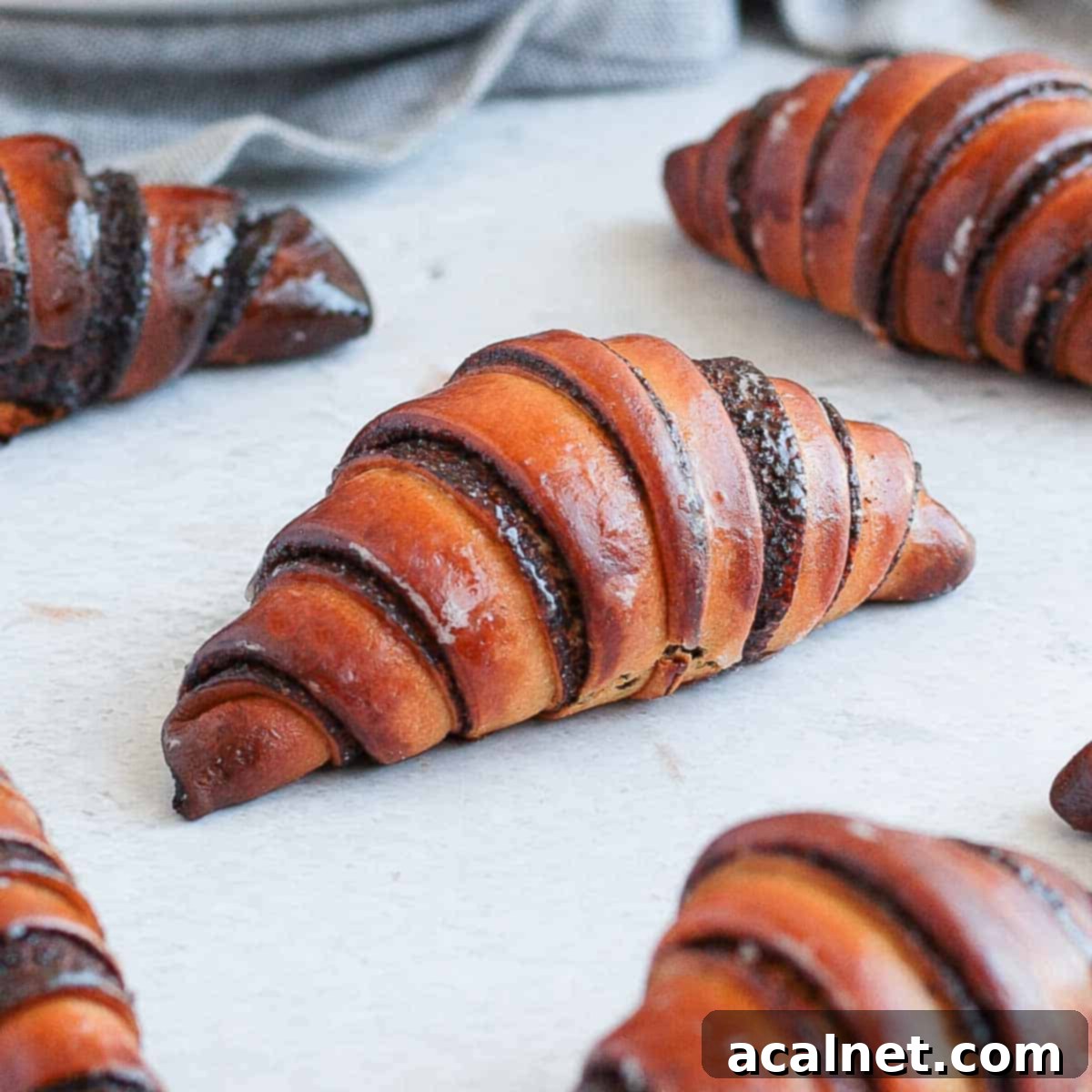Authentic Israeli Yeast Chocolate Rugelach: Fluffy, Flaky & Irresistible Pastries
Dive into the delightful world of Israeli Chocolate Rugelach, where a rich, fluffy, and utterly flaky yeast dough embraces an intense chocolate filling, all finished with a glossy sugar glaze. These traditional Jewish pastries offer a truly decadent experience, perfect for breakfast, a comforting afternoon tea, or simply as a sweet indulgence any time of day. Prepare to be enchanted by their irresistible charm!
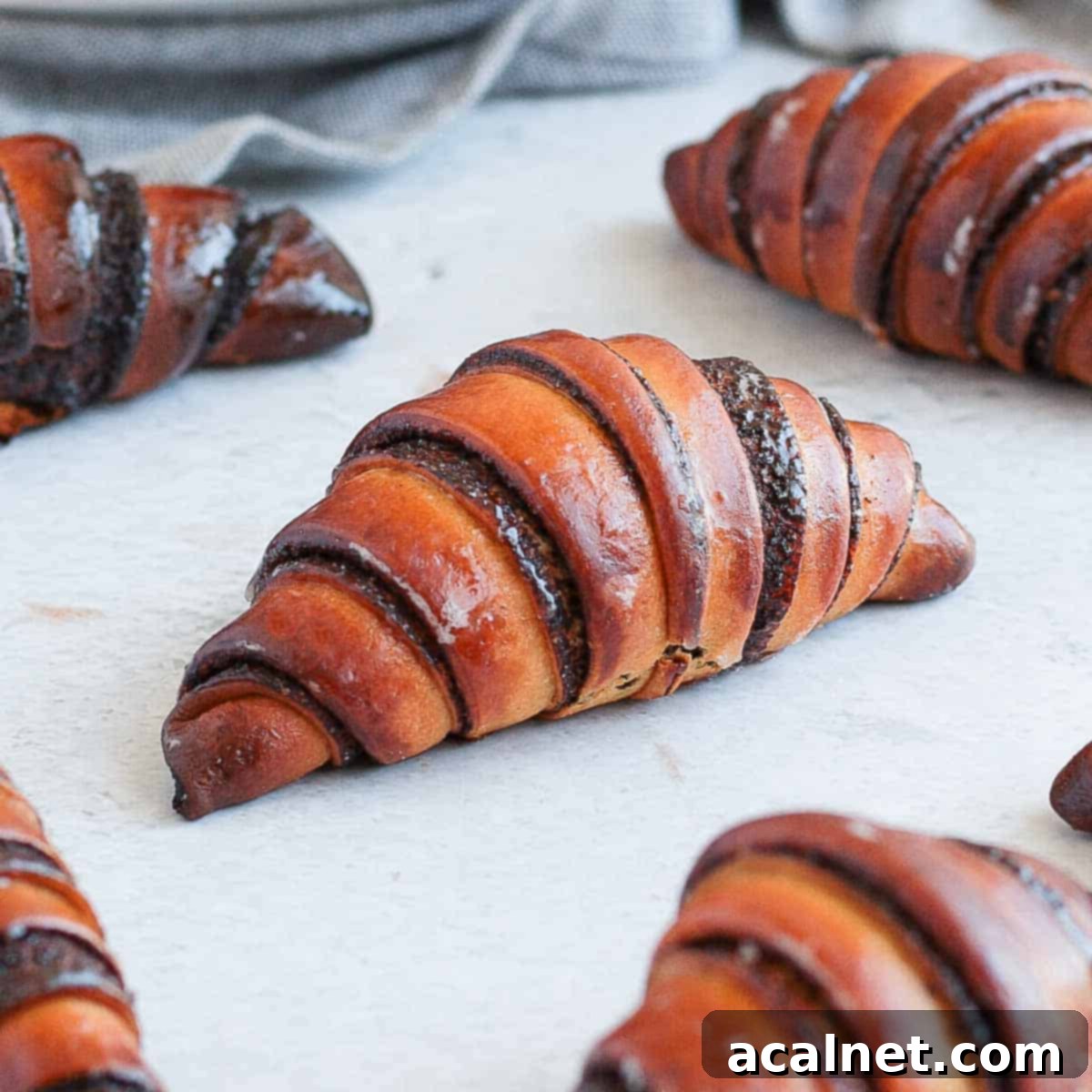
[feast_advanced_jump_to]
Why This Israeli Chocolate Rugelach Recipe is a Must-Try
If your quest is for a Chocolate Rugelach recipe that steers clear of cream cheese, then you’ve stumbled upon a true gem. This recipe introduces you to the authentic Israeli rendition of Rugelach, a delicious departure from the cream cheese-based versions commonly found in North America. Here, the magic begins with a rich, yeasted dough, reminiscent of a brioche or a fluffy babka, paired with a luscious cacao paste filling.
For many, these Israeli Chocolate Rugelach are more than just a pastry; they are a culinary highlight when visiting Israel, and arguably one of the best edible souvenirs one could ever bring back. Forget hard, cookie-like treats; these are delicate, pillowy creations that boast a soft, tender crumb and an exquisite flakiness, enveloping an intense, perfectly balanced chocolate filling. Each bite is a symphony of textures and flavors, crowned with a glistening sugar glaze that adds just the right touch of sweetness and shine. They are simply heavenly, delivering a depth of flavor and a unique texture that truly sets them apart.
What Are Rugelach? A Glimpse into This Beloved Jewish Pastry
Rugelach, a name derived from Yiddish meaning “little twists” or “rolls,” are traditional Ashkenazi Jewish pastries celebrated for their unique crescent shape and delicious fillings. While the core concept of a rolled pastry with a sweet filling remains consistent, Rugelach vary significantly across different Jewish culinary traditions.
The most widely known version in the United States typically features a rich dough made with cream cheese, yielding a tender, cookie-like texture. However, our focus here is on the distinctive Israeli-style Rugelach. These are crafted from an enriched yeast dough, which gives them a brioche-like softness and a delightful chewiness. This yeasted dough is then artfully rolled and folded, a technique that creates multiple thin layers, contributing to their signature fluffy and flaky characteristic. This method, somewhat akin to preparing a laminated dough, ensures each rugelach is a masterpiece of texture – light, airy, and incredibly satisfying. The result is a pastry that is ridiculously addictive, with a perfect balance of a rich, sweet dough and a flavorful filling.
The Art of Yeast-Based Dough
The choice of yeast in Israeli Rugelach is a crucial distinction. Unlike cream cheese doughs that offer a more dense, cookie-like crumb, a yeast-based dough provides a profound lightness and an ethereal flakiness. The yeast works its magic, creating air pockets within the dough during proofing and baking, which contributes to the pastry’s fluffy interior. This leavening process, combined with careful rolling and folding, develops the gluten and creates those coveted layers that make these rugelach so special. It’s a method that requires a little more time and patience than a cream cheese dough, but the superior texture and depth of flavor are undeniably worth the effort.
Essential Ingredients for Your Perfect Chocolate Rugelach
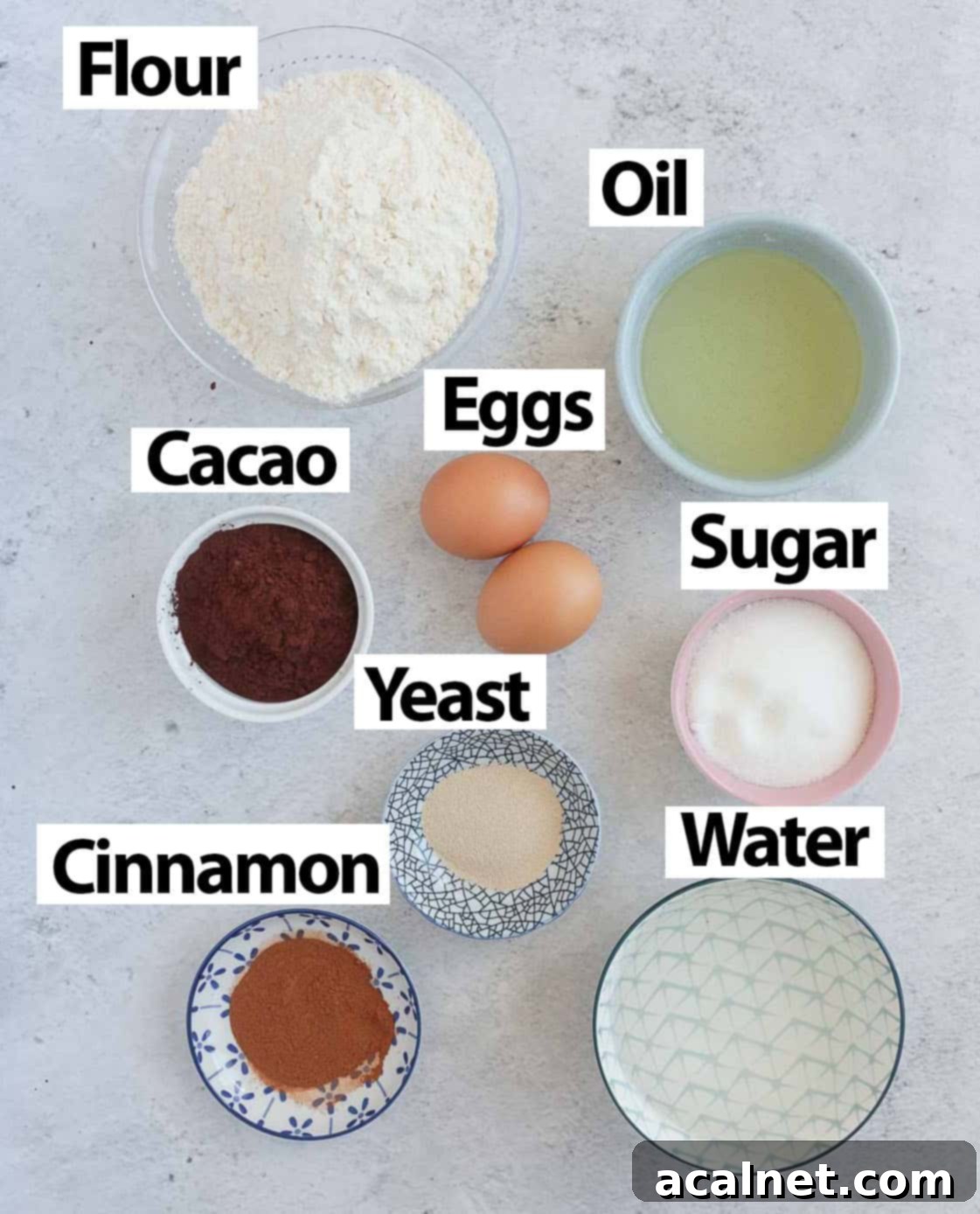
This recipe creates “Parve Rugelach,” meaning they are dairy-free and suitable for consumption with meat, adhering to kosher dietary laws. Instead of butter, we use oil, which also contributes to a lighter texture. The recipe is divided into three essential components: the pastry dough, the rich chocolate filling, and an optional but highly recommended sugar glaze that adds both sweetness and a beautiful sheen. For precise quantities, please refer to the detailed recipe card below.
Pastry Dough Key Ingredients:
- Water: Crucial for activating the yeast. Ensure it’s lukewarm, ideally around 38°C (100°F). It should feel barely warm to your touch – similar to body temperature. If it’s too hot, it will kill the yeast; too cold, and the yeast won’t activate properly.
- Yeast: Instant or Active Dry Yeast works perfectly. If using Instant Yeast, it can often be mixed directly with dry ingredients, but activating it first in warm water with a pinch of sugar (as described in the instructions) ensures it’s alive and ready to work its magic. For more on yeast types, this guide is helpful.
- Sugar: Fine White Granulated Sugar or Caster Sugar is preferred for its ability to dissolve easily and provide the necessary sweetness and tenderness to the dough.
- Eggs: Medium-sized and at room temperature. Room temperature eggs emulsify better with other ingredients, leading to a smoother, more uniform dough.
- Oil: Canola Oil or any other neutral-flavored cooking oil is essential for keeping these rugelach Parve (dairy-free) and contributing to the dough’s moistness and tender crumb.
- Flour: Use Plain / All-Purpose Flour, preferably well-sifted to prevent lumps and ensure a light dough. A touch of Salt is vital for flavor balance and to control yeast activity, while a hint of Cinnamon adds a subtle warmth.
Intense Chocolate Filling Essentials:
- Cacao Powder: Unsweetened Cacao Powder is key to achieving a deep, rich chocolate flavor. Sifting it ensures a smooth, lump-free paste.
- Sugar: While Fine White Sugar is a classic choice, Brown Sugar can be used for a slightly deeper, more caramel-like note in the filling. Adjust to your sweetness preference.
- Oil: Similar to the dough, Canola Oil or any neutral-flavored cooking oil provides the necessary moisture and binds the filling without adding dairy or an overpowering flavor.
- Cinnamon: This is an optional but highly recommended addition. Cinnamon beautifully complements chocolate, adding a layer of aromatic warmth that elevates the entire pastry.
Shimmering Sugar Syrup Glaze (Optional but Recommended):
- A simple yet effective combination of Water and Fine White Sugar. This glaze not only adds an extra touch of sweetness but also gives the baked rugelach a beautiful, inviting sheen and helps keep them moist.
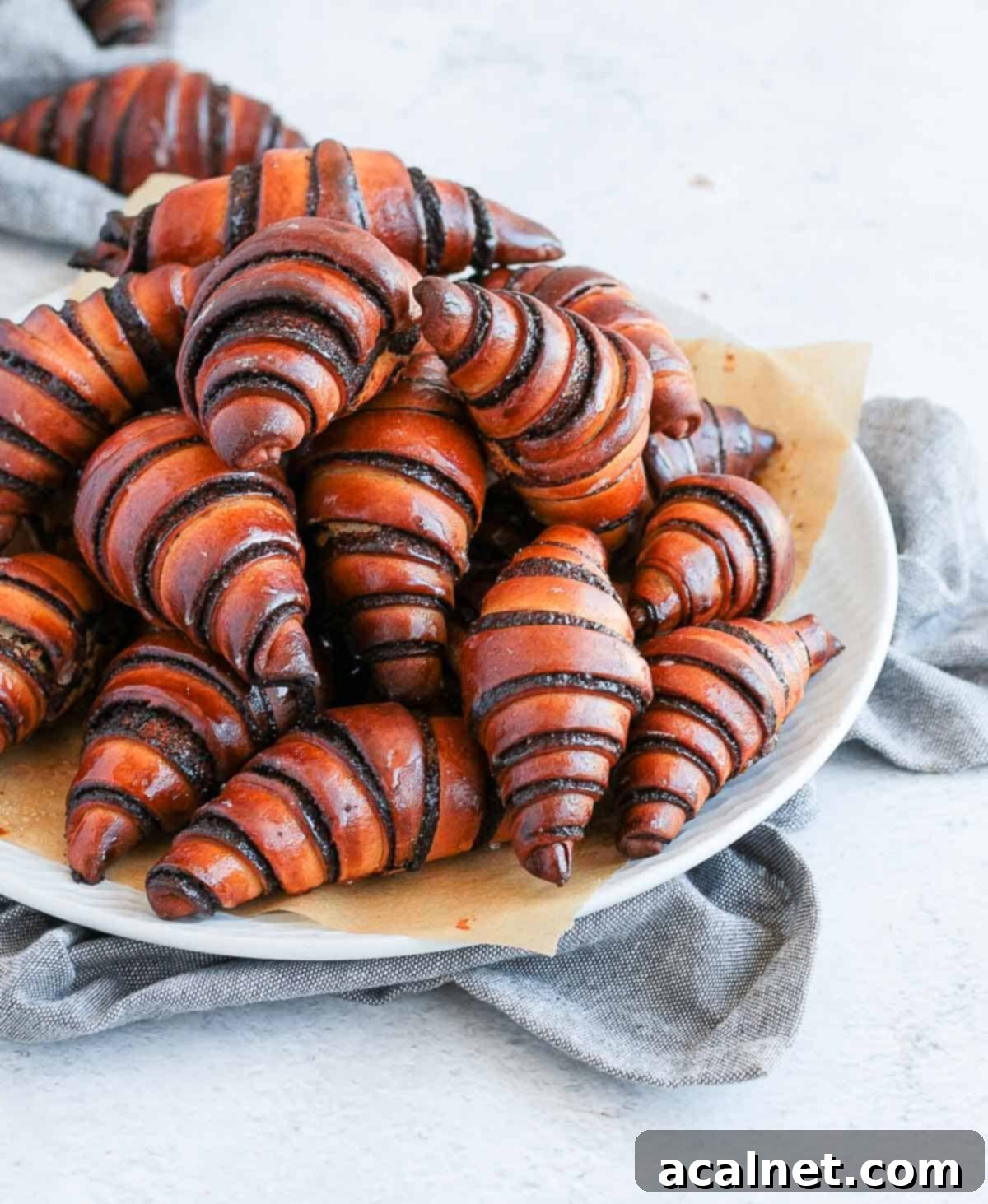
Crafting Perfect Yeasted Chocolate Rugelach: A Step-by-Step Guide
Making these delightful yeasted rugelach is a rewarding journey, primarily broken down into preparing the dough, mixing the filling, and then assembling and baking the pastries. Patience is key, especially during the proofing stages, which allow the yeast to develop the dough’s incredible flavor and texture.
Preparing the Yeasted Dough
The dough is the heart of these rugelach, requiring a little time for proofing but offering immense rewards in terms of flavor and texture. Ensure you allocate approximately 1 to 2 hours for the initial proofing phase.
- Photo 1: Activating the Yeast. Gently warm the water to approximately 38°C (100°F). It should feel comfortably warm, not hot. Whisk in the yeast and one tablespoon of sugar, then set it aside for about 10 minutes. Look for small bubbles or froth forming on the surface; this is your indication that the yeast is active and ready to leaven your dough.
- Photo 2: Combining Wet Ingredients. Once the yeast is active, whisk the eggs and oil into the yeast mixture. These additional wet ingredients will enrich the dough, contributing to its softness and flavor.
- Photo 3: Mixing Dry Ingredients. In the bowl of your stand mixer (or a large mixing bowl if kneading by hand), combine the flour, the remaining sugar, and the cinnamon. Stir them briefly to ensure they are well distributed, then create a small well in the center for the liquids.
- Photo 4: Adding Liquids to Dry. Pour the combined wet ingredients into the well in the dry ingredients. This method helps to gradually incorporate the liquids and prevents the flour from flying everywhere when mixing starts.
- Kneading the Dough. Attach the dough hook to your mixer and knead on medium-high speed for approximately 8 to 10 minutes. The kneading time can vary slightly depending on your mixer’s power and the flour’s protein content. The goal is a dough that is smooth, soft, and elastic. If kneading by hand, this process will take around 15-20 minutes on a lightly floured surface. Remember to add the salt a couple of minutes into the kneading process; adding it too early can inhibit yeast activity.
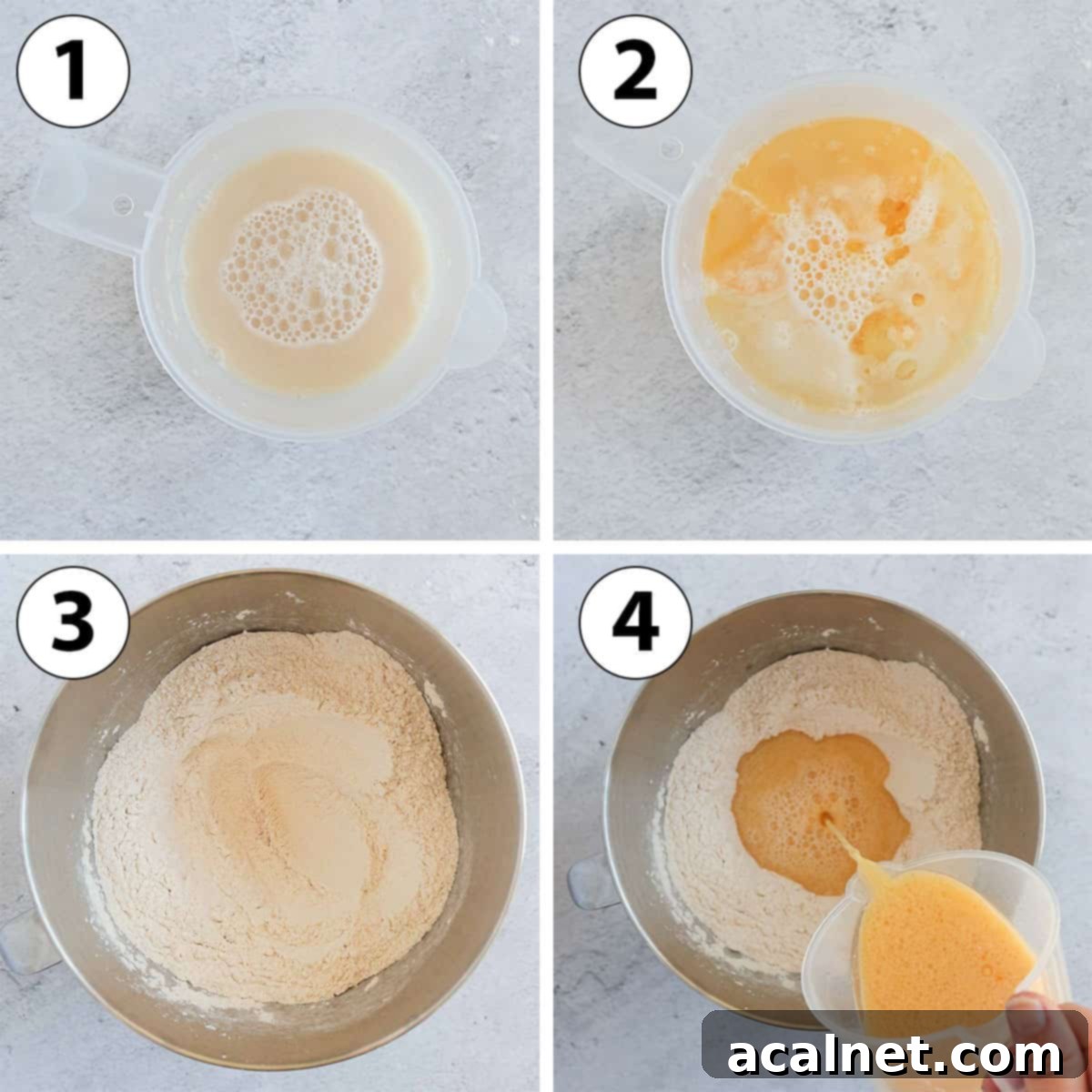
- Photo 5 & 6: First Proofing. Transfer the kneaded dough to a large, lightly greased mixing bowl. Cover it with a clean tea towel or plastic wrap. Allow it to proof in a warm, draft-free place for 1 to 1.5 hours, or until it has visibly doubled in size. This proofing stage is crucial for developing flavor and texture.
Preparing the Decadent Chocolate Filling
While your dough is proofing, you can quickly prepare the rich chocolate filling. This paste is simple yet delivers a powerful chocolate punch.
- Photo 7: Combining Filling Ingredients. In a small mixing bowl, combine the sifted cacao powder, cinnamon (if using), sugar, and oil. Sifting the cacao powder beforehand is important to avoid lumps in your filling.
- Photo 8: Mixing for a Thick Spread. Mix all ingredients thoroughly until you achieve a thick, uniform paste. At this stage, it’s highly recommended to taste the filling. You can adjust the sweetness level by adding a little more sugar if desired, ensuring it perfectly suits your palate.
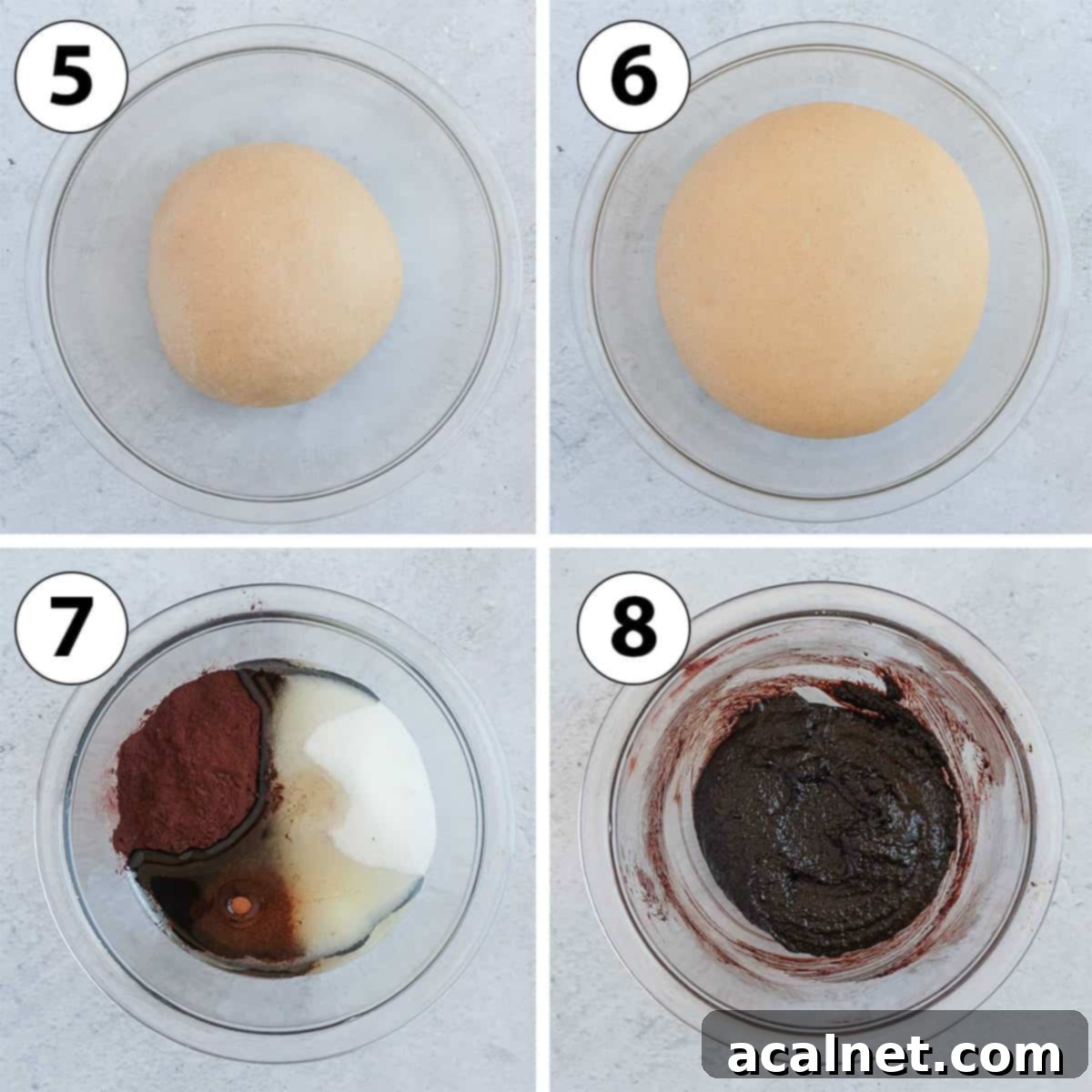
Assembling and Baking Your Chocolate Rugelach
Now that your dough is perfectly proofed and your filling is ready, it’s time to bring these components together to form the iconic rugelach!
- Photo 9: Rolling the Dough. Gently punch down the air from the proofed dough and transfer it to a lightly floured surface. Divide the dough into two equal halves. Take one half and roll it into a large rectangle, approximately 30×50 cm (12×20 inches). The key here is to roll it as thinly as possible without tearing the dough, which will create many delicate layers.
- Photo 10: Spreading the Filling. Evenly spread half of the prepared chocolate filling over the rolled-out dough. Use the back of a spoon or an offset spatula to ensure a uniform layer, reaching almost to the edges.
- Photo 11: Folding and Rerolling. Carefully fold the dough in half along its longer side. Then, gently roll it out again with your rolling pin, aiming to flatten it as much as possible until it’s almost translucent. Don’t worry if some chocolate filling peeks out; it’s a normal part of the process and adds to the rustic charm! This folding and rerolling technique is what gives the rugelach its characteristic flaky layers.
- Photo 12: Cutting Triangles. Using a sharp knife or a pizza cutter, cut the dough into small triangles. The width of the base of your triangles will determine the size of your rugelach crescents. Experiment with sizes to find your preference!

- Photo 13: Rolling into Crescents. Carefully pick up each triangle and roll it into a crescent shape, starting from the wider base and rolling towards the pointy tip. Once rolled, ensure the pointy end is tucked underneath the rugelach. This helps to secure its shape during baking and prevents it from unrolling.
- Photo 14: Arranging for Second Proof. Place each formed rugelach on a large baking tray lined with baking paper or a silicone baking mat. Leave ample space between each pastry, as they will expand and rise during the second proofing and baking.
- Optional Egg Wash. For a beautiful golden-brown finish, whisk an egg yolk with a tablespoon of water to create an egg wash, and gently brush it over the surface of each rugelach before the second proof.
- Second Proofing. Repeat the entire process with the second half of the dough and the remaining filling. Once all rugelach are formed and placed on trays, set them aside to proof for a second time, for about 20 to 30 minutes. This short proof helps them become extra light and airy.
- Baking. While the rugelach are undergoing their second proof, preheat your oven to 180°C (350°F). Bake the pastries for approximately 20 minutes, or until they have risen, achieved a beautiful golden color, and the filling is bubbling slightly.
- Preparing the Sugar Syrup Glaze. While the rugelach are baking, prepare your simple sugar syrup. Combine water and fine white sugar in a small saucepan. Bring it to a simmer over medium heat and let it cook for a few minutes until the syrup slightly thickens. It should slowly drip from a spoon, not pour rapidly or cling entirely. Keep it warm.
- Glazing. As soon as the Chocolate Rugelach emerge from the oven, while they are still hot, generously brush them with the warm sugar syrup. This immediate application ensures the glaze is absorbed beautifully, adding moisture, shine, and extra sweetness. If the syrup starts to harden, gently reheat it for a couple of minutes to melt it again. Allow the glazed rugelach to cool completely on the baking tray before serving.

Mastering Your Israeli Chocolate Rugelach: Expert Tips
Achieving bakery-quality rugelach is easier than you think with these helpful tips:
- Optimal Water Temperature for Yeast: If you don’t have a thermometer, test the water temperature with your finger. It should feel like your body temperature – neither hot nor cold. This ensures the yeast activates properly without being killed or remaining dormant.
- Perfect Dough Consistency: Kneading time can fluctuate based on your mixer’s speed, the flour brand, and even humidity. The ultimate goal is a dough that is visibly smooth, wonderfully soft, and stretches without tearing. A good test is the “windowpane test”: pull a small piece of dough and stretch it thin; if you can see light through it without it ripping, your gluten is well-developed.
- Ideal Proofing Conditions: Kitchen temperature significantly impacts proofing time. Your dough is perfectly proofed when it has approximately doubled in volume. To check, gently press a finger into the dough; it should slowly spring back but leave a slight indent. If it bounces back immediately, it needs more time; if it collapses, it’s over-proofed.
- Roll Dough Super Thin: This is arguably the most critical step for achieving that signature flaky texture. Roll the dough as thinly as you possibly can, almost translucent, but without tearing it. The thinner the dough, the more layers you’ll create when rolling the crescents, leading to a much lighter and flakier pastry.
- Glaze While Warm: For the best results, brush the sugar syrup over the rugelach immediately after they come out of the oven, while both the syrup and pastries are still warm. This allows the syrup to be absorbed evenly, creating a beautiful, shiny, and moist finish. If your syrup cools and hardens, simply reheat it gently for a minute or two until it’s fluid again.

Frequently Asked Questions About Rugelach
Absolutely! While a stand mixer greatly simplifies the process of making yeasted pastries, it’s certainly not a requirement. To knead the dough by hand, simply work it on a lightly floured (or greased) surface for about 15 minutes until it becomes smooth, soft, and elastic.
The cacao paste filling used here is quite similar to the one featured in our Chocolate Brioche recipe. Many people enjoy experimenting with different fillings, such as a simple chocolate spread or even melted chocolate. However, for these rugelach, I personally advocate for the traditional cacao paste. Melted chocolate can easily burn in the oven, and many chocolate spreads can be overly sweet, potentially overpowering the delicate flavor of the dough. The cacao paste offers a balanced, rich chocolate flavor that complements the pastry perfectly.
These delicious rugelach are best enjoyed fresh, but they can be stored at room temperature in an airtight container or well-covered for up to 3 days. Realistically, they are so good, they probably won’t last that long!
Yes, Chocolate Rugelach can be frozen. For best results, freeze them after they have cooled completely and before glazing (if you plan to glaze them). Wrap them tightly in plastic wrap and then in aluminum foil, or place them in a freezer-safe bag or container. They can be stored for up to 2-3 months. Thaw them at room temperature and then warm slightly in an oven if desired. While still delicious, they might lose a little of their fresh, flaky texture compared to when served fresh.
Variations & Serving Suggestions for Your Rugelach
While chocolate rugelach are undeniably superb, this versatile dough can be adapted to many other delicious variations. Consider fillings like a poppy seed paste, various fruit jams (raspberry or apricot are classic choices), finely chopped nuts (walnuts, pecans, or almonds), or even a combination of cinnamon sugar with raisins. You could also infuse the dough with citrus zest for an extra layer of flavor. Serve these delightful pastries with your morning coffee, alongside a cup of tea in the afternoon, or as a sweet ending to a meal. They are also a wonderful addition to any holiday table or special gathering.
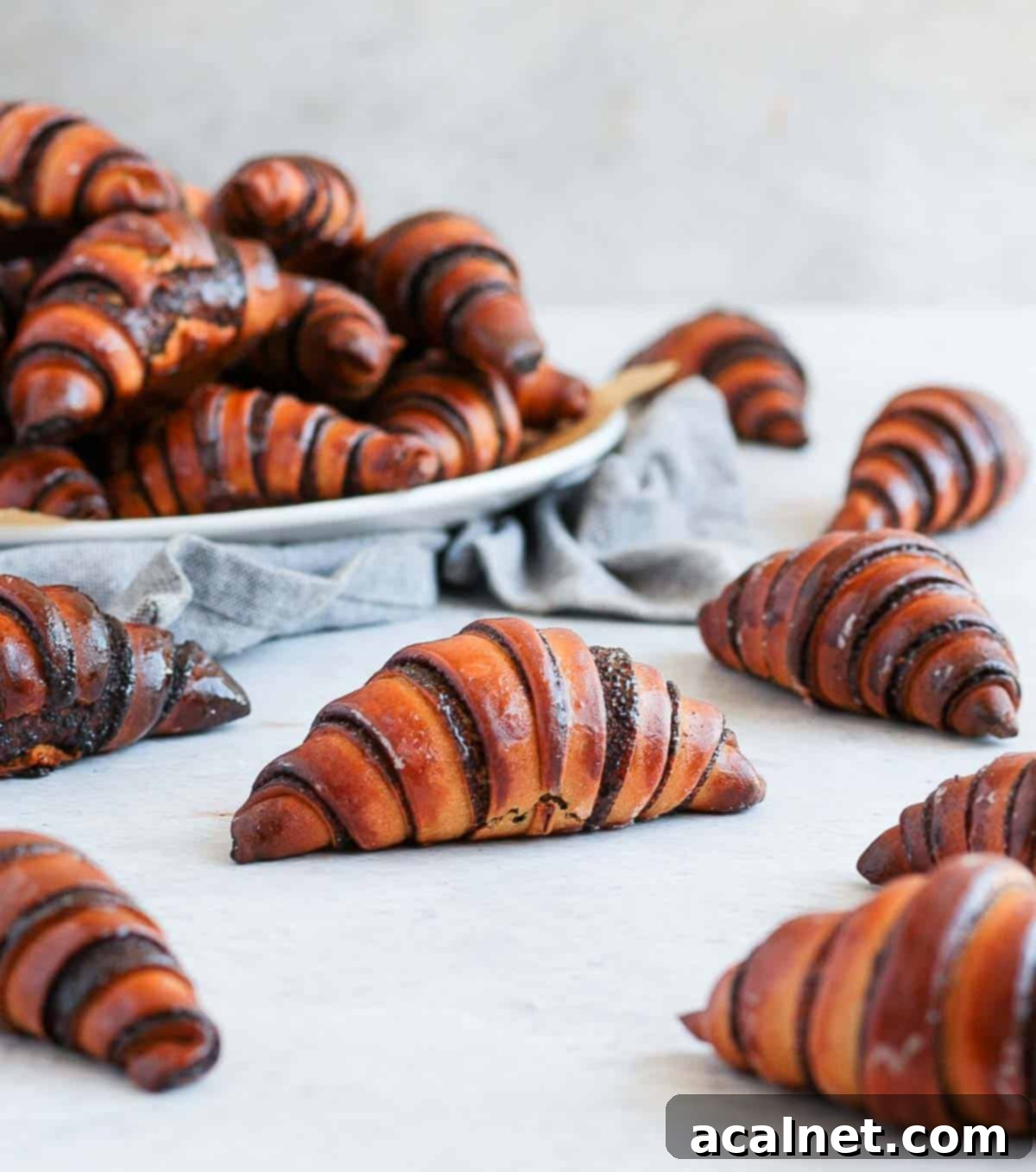
Explore More Irresistible Chocolate Treats
- Peanut Butter Chocolate Muffins
- Double Chocolate Scones
- Chocolate Orange Brownies
- Mini Chocolate Brownie Bites
- Chocolate Cornflake Cakes
- Raspberry Brownies
- French Chocolate Truffles
Made this recipe?
We absolutely love seeing your culinary creations! Please let us know if you enjoyed this recipe by leaving a comment below, and don’t forget to tag us on Instagram @a.baking.journey with a photo of your delicious Israeli Chocolate Rugelach!
Recipe Card: Israeli Chocolate Rugelach (with Yeast)

Israeli Chocolate Rugelach (with Yeast)
Print Recipe
Ingredients
Dough
- 180 ml (3/4 cup) Water, lukewarm
- 7 gr (1 1/2 teasp) Instant Dry Yeast
- 90 ml (1/3 cup) Canola Oil, or Neutral-Flavoured Cooking Oil
- 2 Eggs, at room temperature
- 500 to 550 gr (3 1/3 to 3 2/3 cup) Plain / All Purpose Flour
- 75 gr (1/3 cup) Caster Sugar, or Fine White Granulated Sugar
- 1 teasp. Ground Cinnamon, optional
- 1/2 teasp. Table Salt
Chocolate Filling
- 50 gr (4 1/2 tablesp.) Cacao Powder, Unsweetened
- 80 gr (1/3 cup) Caster Sugar, or Fine White Granulated Sugar
- 1 1/2 teasp. Ground Cinnamon, optional
- 45 ml (3 tablesp.) Canola Oil, or Neutral-Flavoured Cooking Oil
Egg Wash (optional)
- 1 Egg Yolk
- 1 tablesp. Water
Sugar Syrup Glaze
- 50 gr (2 1/2 tablesp.) Caster Sugar, or Fine White Granulated Sugar
- 50 ml (3 tablesp. + 1/3 teasp.) Water
Instructions
Dough
- Heat up the water to be lukewarm (about 38’C/100’F), then mix in the Yeast and one tablespoon of Sugar. Stir and set aside for 5 to 10 minutes, or until the you see small bubbles or froth on the surface (see note 1). Whisk in the Oil and Eggs.
- In the bowl of your stand mixer (or a large mixing bowl if making my hands), mix together the Flour, rest of the Sugar and Cinnamon. Make a well at the centre of the bowl and pour in the Liquids.
- Knead with the hook attachment for about 8 to 10 minutes on medium high speed. After a couple of minutes of kneading, add the Salt. The dough should be soft, smooth and stretchy (see note 2).
- Place the dough in a large, slightly greased bowl. Cover with a tea towel and leave to proof if a warm place for 1 to 1,5 hours, or until doubled in size.
Chocolate Filling
- Mix together the Cacao, Sugar, Cinnamon and Oil to get a thick paste (see note 3).
Assembling the Rugelach
- Punch the air out of the proofed dough and cut it in half. Set one half aside. On a lightly floured surface, roll the second half of dough into a large rectangle about 30×50 cm / 12×20 inch.
- Spread half of the Chocolate Filling over the rolled dough, then fold it in half on its longest side. Roll again with a rolling pin, trying to get the dough as thin as possible without ripping. You should get a very large and thin rectangle and be able to see the filling through the dough.
- Use a sharp knife or a pizza cutter/wheel to cut the dough into triangles (see note 4). Roll each triangle into a crescent, starting from the largest side and rolling towards the pointy end (see note 5).
- Place on a large baking tray lined with baking paper or a baking mat, leaving space between each rugelach as they will expand and rise.
- Repeat the process with the second half of the dough, then set aside to proof for 20 to 30 minutes.
- Optional: whisk an Egg Yolk and Water to make the Egg Wash, and gently brush it over each Rugelach.
- Preheat your oven on 180’C/350’F, then bake for about 20 minutes or until each pastries has risen and looks golden.
Sugar Syrup Glaze
- While the rugelach are baking, prepare the glaze. Mix the Water and Sugar in a small saucepan and turn on medium low heat. Leave to simmer for a few minutes, until you get a thicker syrup consistancy (see note 6). Keep warm until ready to brush.
- Brush on the Rugelach as soon as they come out of the oven, then set them all aside to cool down completely.
Would you like to save this recipe?
We’ll email this post to you, so you can come back to it later!
Notes
Ingredients Notes:
Flour: Start with 500 gr (3 1/3 cup). If after kneading for a few minutes, the dough seems to be very sticky and wet, add a little more. Depending on the brand of flour you use, you might need a little bit more or less. Always start with less and add if needed to avoid getting a dry dough.
Instructions Notes:
- The bubbles/froth indicate that the Yeast is alive and activated, and the warm water will help the process. If are 10 minutes or so, you still do not see a reaction, it is possible that the yeast is not alive and you will need to start again with another batch of yeast. If using Instant Yeast, it does not need to be activated in the water and can be added with the rest of the dry ingredients directly.
- To know that the dough has been kneaded enough, pull and stretch a small bit of dough. It should easily stretch out and you should be able to see through the dough without it ripping.
- Taste and adjust the sweetness level to your liking if desired.
- The wider the triangles are, the bigger the rugelach will be.
- The ‘pointy’ end of the rugelach should face down so that it does not lift up while baking.
- The syrup should still be slightly runny. If very liquid, keep cooking. If thick, you have cooked it for too long. It should be able to be brushed over the warm rugelach but thick enough to stick enough and not drip straight down. If the glaze starts to harden when you are brushing it over the rugelach, reheat for a couple of minutes to melt the sugar again.
Nutrition (per serving)
